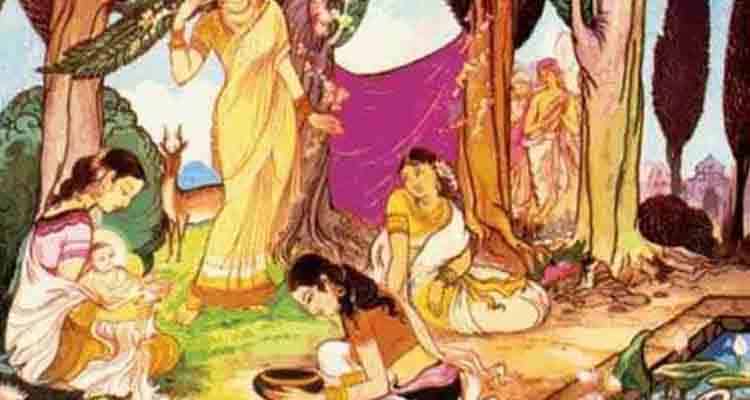LGBT Themes in Hindu Mythology
However, for many of us, queer romance is not only healthy but also beautiful, as beautiful as a straight couple, if not more. If we look at LGBT themes in Hindu mythology, there are ample incidences which resonate with our modern conception of same-sex love being acceptable. The story of Bhagiratha from Bengal is one such tale that celebrated queer love with aplomb. Bhagiratha is a prominent mythical figure not only because he is born to two queens but also as the king who brought Ganga from heaven to Earth. Have you ever wonder why Ganga is called Bhagirathi? Well, you have your answer! So let us begin tracing the legend of King Bhagiratha’s birth and counter the notion that same-sex parents cannot raise competent children!
Tracing the legend of King Bhagiratha’s birth
King Dilipa, an emperor of the Suryavansh Dynasty of the Ramayana, was deeply troubled by the fact that he had no son or heir to continue his legacy. This was the lineage in which Lord Ram was supposed to take birth in. He made countless efforts and underwent severe austerities to be granted a son. This was problematic not only materially because Ayodhya lacked a king, but also spiritually because according to cosmic design, Vishnu was meant to take birth in the same lineage. That the line of succession inadvertently coming to an end was certainly not good news for the gods.
A queer love story gets the stamp of approval
When the worried wives approached their family priest for advice, he assured them that a son would soon be born to them. He prepared a potion for them and encouraged the ladies to engage in intercourse – thus, setting into motion an unconventional relationship. Conventionally, widows are expected to practice celibacy and lead a solitary lifestyle without seeking any pleasure or indulgence. Contrary to this tradition, queens Chandra and Mala embarked on a journey that is representational of modern widows who carve their paths. The real win lies in the fact that their relationship was not merely based on a sexual outcome to save the kingdom, but was the beginning of a true love story between two co-wives once their man was out of the picture. As they took baths together and embraced their rebellious desire for each other, their sexual union was blessed by Kamadeva, the god of desire. He represents an irresistible desire that renders one helplessly attracted.
Co-wives to lovers
Queens Chandra and Mala indulged in and enjoyed love play (keli karitey) in their late husband’s bedroom. It is said that they kissed deeply and made love in the monsoon, which is considered a conventional romantic season. Their lovemaking is not viewed as only transcendental or miraculous. It is equated with everyday lovemaking – a kind of normalization our society could use today. Their interaction is a play of impulse, attraction and pure madness. An aspect of polygamy that’s often disregarded is that not only a husband and his wife but also co-wives are meant to spend their entire lives together. Besides their relationship with their husband, these women also share a bond. The relationship between co-wives is associated with the stereotype of embitterment and envy, whereas they often co-existed within the framework of a certain camaraderie. So perhaps, blossoming of love between them should not come as a surprise, since they spend most of their time around each other and are bound to exist as more than just rivals. It would be daring to suggest that perhaps this divine birth was a pretext for their union. Moreover, Indian mythological stories have provided us with many instances of non-penetrative conception, such as birth from the sperm alone or birth from one of the elements of nature such as fire or air. A story representing two co-wives engaging with one another, thus, cannot merely represent a means to an end for there are other ways of doing that. Their intimacy is not only necessitated but described beautifully, as any other lovemaking would.
A king is born
Soon after the sexual encounter between the co-wives began, the elder of the two, queen Mala, conceived and gave birth to a baby boy. At first, it appeared frightful to them. Mala even tried to commit suicide because of how flummoxed she was by having bearing and birthed a child out of this unconventional love bond.To calm their worries, the Gods stepped in again, this time to reassure them that the birth of a baby was not unnatural but a blessing that they should accept gracefully. Not only is this story a win for same-sex love, but also same-sex parenting! Several theories revolved around the birth of Bhagiratha. Some say that he appeared as a lousy ball of flesh without any bones at all because of his extraordinary conception. An ancient Hindu medical text suggests that the father contributes to the bones of a child, and the mother is responsible for flesh and blood. The same theory tells us that he was later blessed by the sage Ashtavakra, after which he gained the body parts that his mother’s womb could not create. Another theory simply tells us that while he should have been born with a monstrous, deformed appearance, he was born perfectly capable and potent owing to spiritual design behind his birth. Having such a name, he carries this mark of the strength that represents the strength of womanhood. Their physical unity portrays the unity of two resilient, endearing women. If we look at a global history of love between women, the love story of queen Chandra and Mala will stand out as one with no negativity or hindrance. Their love is shown to be pure, ecstatic, for the greater good and most importantly, conveniently acceptable.



